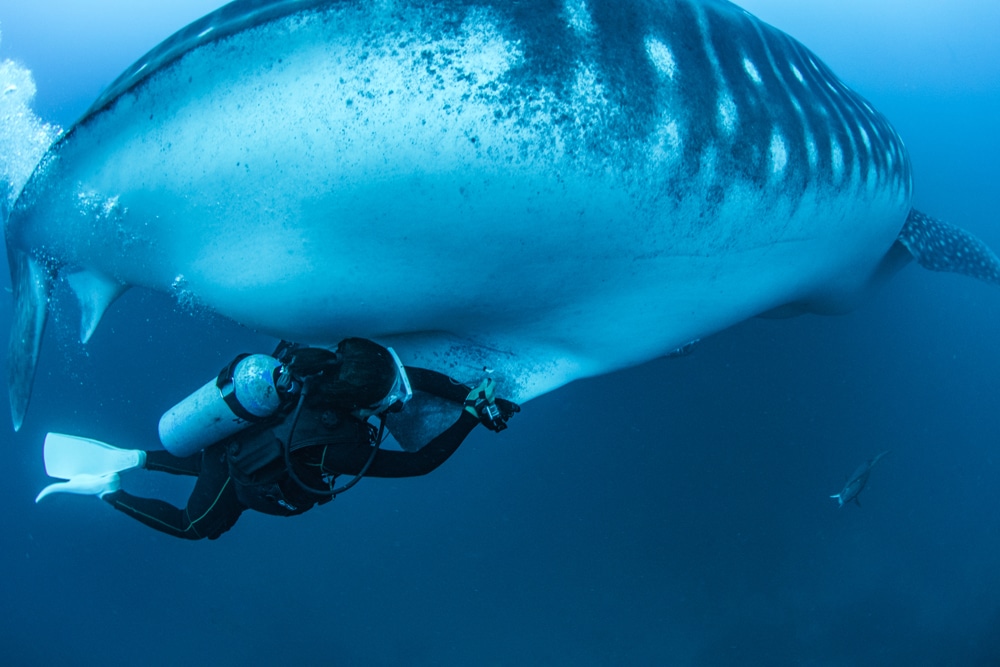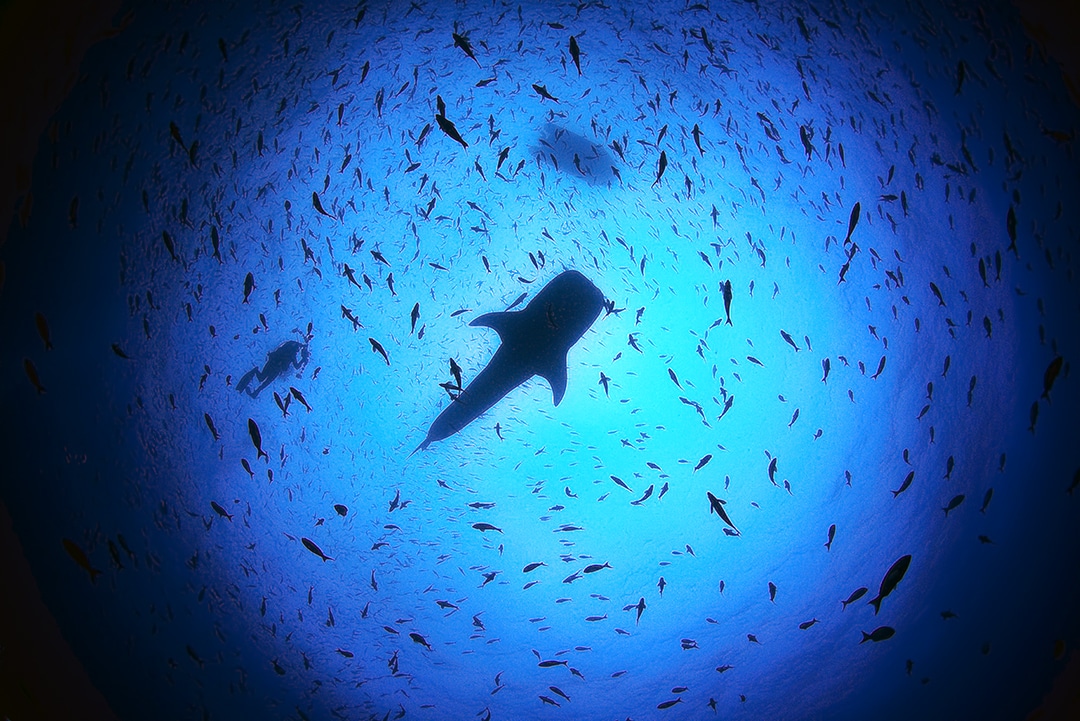News
Underwater ultrasound & first ever blood sampling on adult Whale Sharks

 Innovative techniques used on whale sharks in the Galapagos to find out more about their reproduction
Innovative techniques used on whale sharks in the Galapagos to find out more about their reproduction
Researchers in the Galapagos have successfully completed ultrasounds on free-swimming whale sharks, and taken blood samples from adult whale sharks for the first time ever in the wild. The incredible results allowed them to see and identify reproductive organs, such as the ovaries, and even developing follicles. These technologies hold promise for finally unlocking the mystery of breeding in the world’s largest sharks.
A team of global whale shark experts, comprised of scientists and conservationists from the Galapagos Whale Shark Project (Ecuador), Galapagos National Park (Ecuador), Okinawa Churashima Foundation (Japan), University of San Francisco/Galapagos Science Center (Ecuador) and the Marine Megafauna Foundation (USA), has just returned from a two-week expedition to Darwin Island, in the far north of the Galapagos Archipelago.
This remote volcanic island is one of the few places where huge adult female whale sharks, up to 14 m (45 ft) in length, are commonly seen each year. The main aim of the expedition was to assess the sharks’ reproductive state.
Jonathan R. Green, the expedition leader and founder of the Galapagos Whale Shark Project, notes: “Almost nothing is known about the reproduction of these giant sharks. After I first saw these huge female whale sharks in the far north Galapagos, I realised that this was a great opportunity to learn more. We’ve been able to put together an experienced team to research sharks in this remote area, one of the world’s most isolated dive sites.”
Dr Simon Pierce, an expedition member from the Marine Megafauna Foundation, explains further: “Whale shark breeding is a mystery. Only one pregnant shark has been physically examined so far, back in 1995 in Taiwan. That ‘megamamma’ shark had 304 little whale shark eggs and pups inside, all less than 60 cm in length.”
The team conducted scans using a 17 kg ultrasound system in a waterproofed case. Whale sharks have tough protective skin, more than 20 cm thick on some individuals, so the 30 cm penetration of the ultrasound waves proved a challenge – not to mention the difficulty of carefully checking the whole belly area of a gigantic shark while it is swimming. Dr Matsumoto had to use a propellor system mounted on his air-tank to keep up with the sharks.
“We use some interesting technology anyway, but working with the Okinawa team was something else”, commented Dr Pierce. “I felt cool by association. We saw dive groups a couple of times at the site, and I can only imagine what they thought – why is that guy diving with a briefcase? And a jetpack?”
Dr Matsumoto reports that the initial results were promising: “We confirmed the presence of follicles in the ovaries but none of the images captured embryos or egg capsules inside the uterus. These adult female sharks we saw at Darwin Island might be on their way to mate further offshore. I am confident that we can judge the sexual maturity, and probably also determine the pregnancy of whale sharks in the field, using the underwater ultrasound”.
The researchers attached satellite-linked tags to the sharks to track their onwards movements. Professor Alex Hearn from the University of San Francisco/Galapagos Science Center explains: “We’ve tagged whale sharks in Galapagos before, but there are lots of predatory sharks at Darwin and they often try to eat the tags, which can rip them out of the whale sharks almost immediately. To reduce early tag loss, we tried a different method on this trip, clamping the tags to the tip of the dorsal fins. All tags are transmitting well, so we should get great information on where these sharks swim over the months to come.”
Project member Dr Alistair Dove, from Georgia Aquarium, notes that these tags could document some amazing behaviours: “Whale sharks are already known to be the deepest-diving of all fish. The current depth record is 1,928 m – well over a mile – set by a juvenile whale shark. Larger, older animals can generally dive deeper than young smaller ones, so perhaps we will challenge that record.”
Kiyomi Murakumo, from Okinawa Churashima Foundation, successfully collected blood samples from six adult sharks – no easy job. Her colleague, Dr Ryo Nozu, analyzed the results immediately following the trip: “Sex steroid hormone levels in the blood are an excellent way to monitor reproduction in individual sharks. This study measured levels of estradiol, progesterone and testosterone of wild, adult female whale sharks for the first time in the world. Estradiol could be associated with follicular development, and progesterone could be involved in ovulation and pregnancy. Over time, as we sample more whale sharks, we can build up a complete picture of their reproductive cycle by combining the blood sampling with the ultrasonography.”
Jonathan R. Green added: “These big female sharks are not going to give up their secrets easily. One thing is clear: there’s a lot of work still to do to understand the reproductive processes of this endangered species. However, this trip proved that it is possible to research their breeding in the wild. We’ll continue to hone our techniques and build upon this knowledge, as we need to understand these enigmatic sharks and protect them through their life cycle.”
This project was supported by Galapagos Conservation Trust, Planeterra Foundation and Temperatio.
Photo Credit: GWSP page – www.
For more information about the Marine Megafauna Foundation please visit their website by clicking here.
Gear News
Introducing the TR-80, IR-50 and CS-30 Regulators from DYNAMICNORD

Whether you are a beginner or a professional diver – with the three new main regulators from DYNAMICNORD, everyone will find their favourite regulator. They all look super stylish.
Excellent performance with the TR-80
Quality and performance are the be-all and end-all for regulators. It is not for nothing that the TR stands for Tec Reg. The innovative design of the TR-80 guarantees absolute reliability – even in ice-cold waters.

Perfect breathing effort at 0.8 J/l / certified for diving in waters below 10 degrees / structural design made of solid brass for best cold protection / membrane-compensated design with dry seal of the first stage / reduced exhalation effort thanks to optimized exhalation membrane and bubble deflector / adjustable Venturi (dive/predive) and adjustment knob for individual inhalation comfort / innovative design of the front cover prevents free-flow in strong currents or when diving with scooters / design made of sandblasted brass, matt chrome finish / 2 HP and 4 LP outlets / mouthpiece made of high-quality, anti-allergic silicone for maximum comfort.


Amazing underwater adventures with the IR-50
The IR-50 is the top regulator for advanced and experienced divers. Natural breathing is the essence of this regulator.

Ideal breathing effort at 0.8 J/l /certified for diving in waters below 10 degrees / compensated membrane / adjustable venturi (dive/predive) and adjustment knob for individual inhalation comfort/ outlet valve and deflector for minimum exhalation effort and reduction of bubbles on the face / design made of sandblasted brass, matt chrome finish / 2 HP and 4 NP outlets / mouthpiece made of high-quality, anti-allergic silicone for maximum comfort.


The Workhorse – our CS-30
For diving centres and diving beginners – the workhorse stands for strong construction, reliability and robustness. Perfect for your training.

Optimal breathing effort at 0.8 J/l /recommended for diving in waters above 10 degrees / non-compensated piston / adjustable venturi (dive/predive) / outlet valve and deflector for minimum exhalation effort and reduction of bubbles on the face / design made of sandblasted brass, matt chrome finish / 1 HP and 3 NP outlets / mouthpiece made of high-quality, anti-allergic silicone for maximum comfort.


Octopus OP-30
The OP-30 is the ideal addition to all DYNAMICNORD regulators. It is identical in construction to the CS-30.

The TR-80, IR-50, CS-30 (DIN & INT) regulators and the Octopus OP-30 are available from DYNAMICNORD dealers and in the online store.
DYNAMICNORD – Your Outdoor Companion.
Marine Life & Conservation
Paul Watson Released as Denmark Blocks Japan’s Extradition Bid

Renowned anti-whaling activist Paul Watson has been released from custody in Greenland after spending five months in detention. Denmark’s Justice Ministry rejected Japan’s request for his extradition, citing insufficient guarantees that his time already served in custody would be credited against any potential sentence.
The 74-year-old Canadian-American was arrested on July 21 in Nuuk, Greenland’s capital, when his ship docked to refuel. His arrest was based on a 2012 Japanese warrant related to a 2010 encounter in Antarctic waters. Japan alleged Watson obstructed operations and caused damage to a whaling research ship during efforts to disrupt illegal whaling. Watson has consistently denied these claims, maintaining his commitment to marine conservation.
Denmark, which oversees extradition matters for Greenland, concluded that while the legal conditions for extradition were met, the lack of assurances from Japan regarding time-served credit made extradition untenable.
In a video shared by his foundation, Watson expressed gratitude and relief, saying, “After five months, it’s good to be out… and good to know they’re not sending me to Japan.” He added that the most difficult part of his time in custody was being separated from his two young sons.
Watson is a pioneering figure in marine conservation, known for founding the Captain Paul Watson Foundation in 2022 after decades of activism with the Sea Shepherd Conservation Society. His bold efforts to defend marine life have earned him widespread support, including from celebrities and conservationists. His work has also been featured in the acclaimed reality TV series Whale Wars.
Watson’s lawyer, Jonas Christoffersen, praised the decision, stating, “We are happy and relieved that Paul Watson is now free.” He added that Watson is eager to reunite with his family and continue his vital work.
The arrest occurred while Watson’s vessel, the M/Y John Paul DeJoria, was en route to the North Pacific with a team of 26 volunteers to intercept a Japanese whaling ship. His foundation described the arrest as politically motivated and emphasized that Watson’s actions were focused on ending illegal whaling practices.
Japan resumed commercial whaling in 2019 after leaving the International Whaling Commission, asserting that whale meat is a cultural tradition. Conservationists, however, continue to challenge these practices, highlighting their impact on marine ecosystems.
Despite the challenges, Watson remains steadfast in his mission to protect marine life and bring attention to whaling practices. His dedication to ocean conservation has made him a globally respected advocate for the environment.
-

 News2 months ago
News2 months agoIconic SS United States to become the World’s Largest Artificial Reef
-

 News3 months ago
News3 months agoBook Review – 52 Assignments: Underwater Photography
-

 Gear News3 months ago
Gear News3 months agoDYNAMICNORD – New German diving brand enters the British market
-

 News3 months ago
News3 months agoExploring Cenote El Pit: A Diver’s Dream
-

 Gear News3 months ago
Gear News3 months agoTry BARE drysuits (and maybe even win one!) this Friday with Sea & Sea at North West Dive Fest
-

 Marine Life & Conservation3 months ago
Marine Life & Conservation3 months agoBook Review: Coral Triangle Cameos
-

 Blogs2 months ago
Blogs2 months agoDive the Egyptian Red Sea this Autumn with Regaldive
-

 News3 months ago
News3 months ago2024 Ocean Art Underwater Photo Competition Announced


















